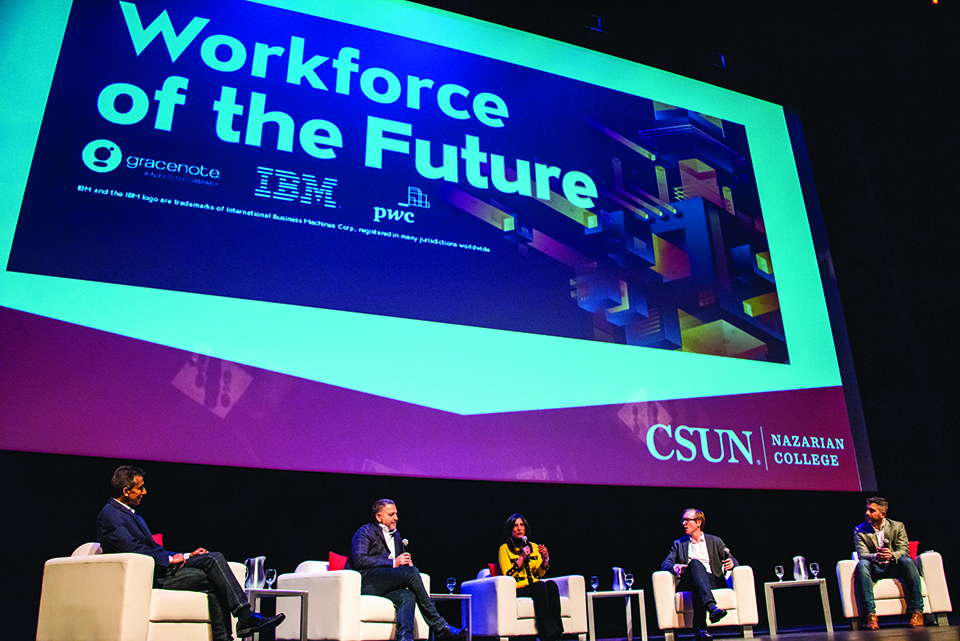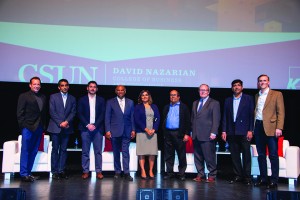
A series of annual Workforce of the Future symposiums attracted more than 600 students, faculty, alumni, and business and academic leaders from across Southern California to CSUN’s Younes and Soraya Nazarian Center for the Performing Arts, highlighting the valuable collaboration between the business school and its corporate partners.
By Steve Arel
CSUN’s workers of the future are setting themselves apart — in a good way — in the financial tech industry, through the aptly named Workforce of the Future program.
Launched in 2018, the project was born of a need to, with the help of leading industry partners, close skill gaps in technical areas and personal abilities, such as leadership, communication and critical thinking.
“What do our students need to do to prepare themselves?” asked Robert Sheridan, executive director of the Career Education and Professional Development Center in the Nazarian College. “Academic work at CSUN is rigorous. There’s a lot to learn. At the same time, the world is drastically changing before our eyes. What employers care about is whether you are ready on day one.”
The next evolution of the workplace will be shaped — and in many ways, is already being shaped — by artificial intelligence (AI), the Internet of Things (the network of physical objects embedded with sensors, software and other technology in order to connect and exchange data), blockchain, smart contracts and a host of technologies yet to emerge.
“Together, these technologies can displace massive numbers of jobs, but at the end of the day, there will still be work that needs to be done,” Sheridan said. “Our faculty is preparing our students to succeed in an increasingly competitive environment.”
The Workforce of the Future concept has become a model at the Nazarian College for blending curricular and co-curricular programming, with a singular focus on student success.
Much of the program’s relevance entails bringing in guest speakers and instructors who experience the real-world challenges of the workforce every day. Participating industry leaders have included IBM, Nielsen Co., PricewaterhouseCoopers and KPMG — all companies with considerable size, reputation and global reach.

Steve Canepa (standing, on far left), IBM’s global GM & managing director, Communications Sector, helped launch the program as the series’ first keynote speaker in 2018.
Steve Canepa, IBM’s global GM & managing director, Communications Sector, helped launch the Workforce of the Future program as the series’ first keynote speaker in Nov. 2018. Canepa discussed the applications and societal implications of IBM’s massive AI engine, Watson.
Utpal Mangla, vice president and senior partner at IBM, was another guest speaker who took the symposium stage and has been integral in planning the events, in partnership with Sheridan.
The challenges facing future workers are clear, he said. He pointed to indicators such as the Global Talent Competitiveness Index, which suggests that the emergence of new technologies will require massive re-skilling of the worldwide workforce within the next five years.
That’s why, Mangla said, it’s incumbent upon universities such as CSUN and public and private entities to collaborate to ensure students stand out and take advantage while riding the wave of innovation.

Utpal Mangla, vice president and senior partner at IBM, was another guest speaker who took the symposium stage and has been integral in planning the events.
“The digital transformation has created significant opportunities,” he said. Helping students take advantage of these transformational waves “depends a lot on the university being ahead of the curve and whether it can provide tools they need. I see light because universities are embracing that, and CSUN is a classic example of being a leader. They know there’s opportunity, and they’re enabling their students to be successful.”
Much like the approach it supports, the program quickly has evolved. While symposiums are the visible centerpieces of the Workforce of the Future, the forward-thinking vision has become a theme for the Nazarian College itself.
The Workforce of the Future program isn’t just about the students. It’s also designed to inform the faculty about these trends so they can consider the best ways to prepare their students for future careers. These efforts helped build momentum for important Nazarian College faculty initiatives, such as the creation of data analytics degree programs at the undergraduate and graduate levels.
“It really got the faculty inspired,” Sheridan said.
The program also has inspired considerable innovation among the very active community of clubs and organizations in the Nazarian College. Mangla stepped up as a personal resource to a group of students who formed two vibrant new groups, the CSUN Blockchain Society and AI Innovation group.
Student success is evident. A number of Matadors who attended previous symposiums parlayed what they learned to help them land positions and be successful in those roles.
Mangla hears regularly from many alumni who have quickly ascended the ranks of their firms, and he continues to mentor others students, he said. Students tell him they are thankful for the opportunity they got to help start their careers.
“Technology is constantly evolving,” Mangla said. “I’ve been in the technology industry for over 25 years. I put in 15 hours of personal study every week to stay on top of my field and area of expertise. It is essential to stay current, since industries are constantly getting disrupted by technical innovation.
“Nothing gives me greater pleasure than to hear mentees doing well in their professional careers,” he said. “Seeing the success of students you helped is a fulfilling moment.”
